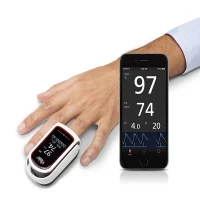Euroanaesthesia Congress Evaluated the Impact on Mortality and Morbidity with Masimo SpHb and PVI
NEUCHATEL, Switzerland, Masimo (NASDAQ: MASI) announced a new clinical study presented at the European Society of Anaesthesiology's Euroanaesthesia 2015 Annual Congress in Berlin, Germany. The study evaluated Masimo's parameters of noninvasive, continuous haemoglobin, SpHb®, and fluid responsiveness, PVI®, with patients in hospital settings.*
Dr. Sebastien Ponsonnard and researchers at CHU Limoges, Department of Anaesthesiology & Intensive Care, in Limoges, France, evaluated the impact on mortality and morbidity in patients who underwent general anaesthesia at the hospital after the introduction of Masimo SpHb continuous haemoglobin measurement and response to fluid loading by PVI.1
Operating rooms and ICUs were equipped with Masimo Radical-7 Pulse CO-Oximeter® monitors. Over a six-month period (Feb. 6-Aug. 7, 2014), patients receiving general anaesthesia were monitored noninvasively.
At one month, mortality decreased in 2014 (vs. 84/5123 = 1.64% vs. 121/5478 = 2.2%, P = 0.024). In-hospital mortality was not different between the two years. Death in cardiothoracic surgery was slightly lower (P = 0.07).
Researchers concluded: "These results suggest that by using a non-invasive monitor, measuring SpHb and fluid loading responsiveness is possible on a large scale. The observed reduction of mortality agrees with multi-centric randomized studies using more invasive monitoring systems2 and support the large use of such a device."
* For CE Marking:
- The Radical-7 is intended for the continuous and noninvasive monitoring of SpO2, SpCO, SpMet and SpHb.
- The Radical-7 with PVI has been clinically evaluated for fluid responsiveness measurements.
For the US market:
- The Radical-7 is indicated for the continuous and noninvasive monitoring of SpO2, SpCO, SpMet and SpHb.
- The Radical-7 with PVI is a measure of dynamic changes in the perfusion index (PI) that occur during the respiratory cycle. The PVI calculation is accomplished by measuring changes in PI over a time interval where one or more complete respiratory cycles have occurred. PVI is displayed as a percent (0-100%). PVI may show changes that reflect physiologic factors such as vascular tone, circulating blood volume and intrathoracic pressure excursions. The utility of PVI is unknown at this time and requires further clinical studies. Technical factors that may affect PVI include probe malposition and patient motion.
- Ponsonnard S, Yonnet S, Marin B, Cros J, Ben Miled S, Nathan N. "Continuous Hb and plethysmography variability index (PVI) monitoring is associated to a decreased mortality at the scale of a whole hospital." Proceedings of the European Society of Anaesthesiology's Euroanaesthesia 2015 Annual Congress, May 30-June 2, Berlin, Germany, 16AP3-2, Room A1 – Poster Abstract Presentation Session, e-Board 8
- Hamilton et al. AnesthAnalg. 2011









